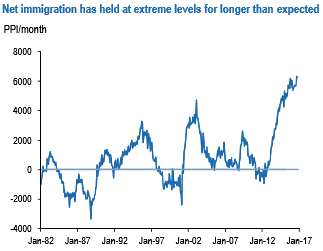The RBNZ said it has ended its easing cycle and will remain on hold until 2020. That will anchor the short end, although markets will not abandon their expectations for earlier tightening which means occasional spikes in the 2yr will be likely.
The long end will continue to follow mainly US yields, which we expect to rise. That means the curve steepening trend should continue.
Granted, the NZ economy is strong and dairy prices have risen, but these forces are subservient to the US dollar’s trend. Better data, but falling real rates and tightening credit keep us bearish.
We expect NZD to fall through this year, reaching 0.62 at year-end. The support to growth from migration will fade, while the RBNZ -at the very least–are likely to hold rates steady as inflation normalizes, pushing real rates materially lower.
Since our NZD outlook piece in November 2016, the economy has continued to perform strongly in real terms. GDP growth was over 1% QoQ in Q3, which would see the economy rounding out the year with annual growth comfortably above 3%. Still, much of the upside surprise in activity indicators is owed to the positive supply shock from migration (see above chart).
We expect that growth impulse to fade through 2017, which would deliver growth performance more in keeping with subdued inflation, and would also remove some of the pressure on housing.
It is even easier for the RBNZ to maintain a low for long bias in an environment where spreads are widening, and delivered mortgage rates are rising. We believe the overvalued exchange rate is preventing sufficient capital inflow to the non-bank economy to compensate for a swelling current account deficit. This has resulted in leakage of NZD liquidity, and rising funding costs for the bank.
The economy is also now subject to credit tightening through numerous channels: macro-prudential constraints, widening mortgage rate spreads, and banks’ discretionary tightening of credit criteria to businesses. We now expect the RBNZ to be on hold this year, but there is a clear downside risk to the OCR in the near term.



 U.S. Stocks End Week Higher as Tech Rally Offsets Consumer Weakness
U.S. Stocks End Week Higher as Tech Rally Offsets Consumer Weakness  Precious Metals Rally as Silver and Platinum Outperform on Rate Cut Bets
Precious Metals Rally as Silver and Platinum Outperform on Rate Cut Bets  BOJ Poised for Historic Rate Hike as Japan Signals Shift Toward Monetary Normalization
BOJ Poised for Historic Rate Hike as Japan Signals Shift Toward Monetary Normalization  Japan Signals Possible Yen Intervention as Currency Weakens Despite BOJ Rate Hike
Japan Signals Possible Yen Intervention as Currency Weakens Despite BOJ Rate Hike  Yen Near Lows as Markets Await Bank of Japan Rate Decision, Euro Slips After ECB Signals Caution
Yen Near Lows as Markets Await Bank of Japan Rate Decision, Euro Slips After ECB Signals Caution  Why U.S. Coffee Prices Are Staying High Despite Trump’s Tariff Rollbacks
Why U.S. Coffee Prices Are Staying High Despite Trump’s Tariff Rollbacks  U.S. Stock Futures Slip After CPI-Fueled Rally as Markets Weigh Economic Uncertainty
U.S. Stock Futures Slip After CPI-Fueled Rally as Markets Weigh Economic Uncertainty  EU Delays Mercosur Free Trade Agreement Signing Amid Ukraine War Funding Talks
EU Delays Mercosur Free Trade Agreement Signing Amid Ukraine War Funding Talks  China Keeps Benchmark Lending Rates Steady as Economic Outlook Remains Cautious
China Keeps Benchmark Lending Rates Steady as Economic Outlook Remains Cautious  Japan Inflation Holds Firm in November as BOJ Nears Key Rate Hike Decision
Japan Inflation Holds Firm in November as BOJ Nears Key Rate Hike Decision  Russia Stocks End Flat as Energy Shares Support MOEX Index
Russia Stocks End Flat as Energy Shares Support MOEX Index  Global Demand for Yuan Loans and Bonds Surges as China Pushes Currency Internationalization
Global Demand for Yuan Loans and Bonds Surges as China Pushes Currency Internationalization  Platinum Price Surges Past $2,000 as Demand and Supply Dynamics Tighten
Platinum Price Surges Past $2,000 as Demand and Supply Dynamics Tighten  Oil Prices Climb in Asian Trade as Venezuela Sanctions and Middle East Tensions Fuel Risk Premium
Oil Prices Climb in Asian Trade as Venezuela Sanctions and Middle East Tensions Fuel Risk Premium  UK Economy Grows 0.1% in Q3 2025 as Outlook Remains Fragile
UK Economy Grows 0.1% in Q3 2025 as Outlook Remains Fragile  China’s Power Market Revamp Fuels Global Boom in Energy Storage Batteries
China’s Power Market Revamp Fuels Global Boom in Energy Storage Batteries 






























